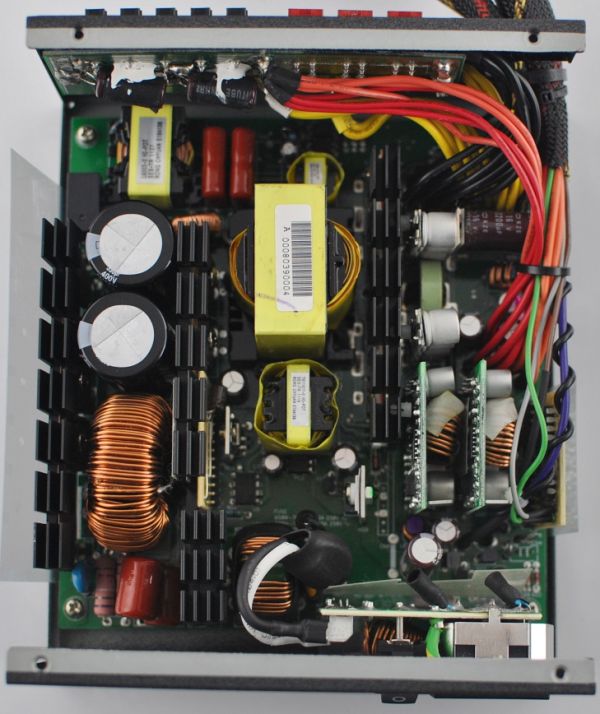Enermax Platimax 750W - 80 Plus Platinum Arrives
by Martin Kaffei on February 10, 2012 6:00 PM EST- Posted in
- Cases/Cooling/PSUs
- PSUs
- 80Plus
- 750W
- Enermax
- 80Plus Platinum
Switching Circuits and Components
The 750W Platimax PSU uses a multi-layer PCB design similar to the Modu87+ series, as well as similar components. The biggest difference is in the transistors, which have a slightly lower turn-on resistance. Enermax still relies on the resonant converter with Zero Voltage Switching (ZVS). Its core is the resonant circuit consisting of a capacitor and a coil; these have specific loading characteristics that make the voltage waveform nearly sinusoidal. The transistors switch at the zero-crossing, which greatly reduces power dissipation. This compensates for the slightly higher losses during saturation (which is no problem with a low resistance between drain and source).
With the improvement in efficiency, manufacturers can also reduce the heatsink size(s). However, even on the secondary side Enermax still uses through-hole components for synchronous rectification instead of SMDs (Surface Mounted Devices). The efficient MOSFETs there could even be cooled by the conductor path. With THT (Through Hole Technology) Enermax is playing it safe, but it also means the fan should be able to run at lower RPMs.
Note that the inductive components get very hot in a switching power supply, which requires additional cooling. The temperature of the chokes can heat all the neighboring components. Enermax seems to know this is a potential problem, which is one reason why they're not making this a passively or semi-passively cooled PSU.
Most of the capacitors are of Japanese make, which is nice to see. Enermax uses a buck converter for -12V, an interesting development. Not long ago -12V was regulated by a linear regulator with large voltage drops. Usually the power dissipation is not a problem on this rail, since the current is low, but even so this is an improvement.
















47 Comments
View All Comments
airmantharp - Friday, February 10, 2012 - link
Did you mean results?Only posted for the humor involved :).
JarredWalton - Saturday, February 11, 2012 - link
There are times when I miss our old CMS system where misspelled words were immediately underlined. Sorry for the error. ;-)Termie - Friday, February 10, 2012 - link
Did I miss it, or did you not actually list the price of the power supply in this article? I would think that would be a critical element of the review. You repeat several times that this is a very expensive power supply, but without a price stated, I don't think your readers will be able to draw any conclusions from this.I know Newegg currently has a paid add running at the top of this article showing its price for this product, but that is not the same thing as stating the price in your article.
JarredWalton - Saturday, February 11, 2012 - link
We linked to the lowest price we could find in the second to last paragraph, but you're right -- nowhere did we actually list the price. I have added that information to the same paragraph now. Thanks!DanNeely - Friday, February 10, 2012 - link
"Does anyone actually detach their CPU/mainboard cables?"2x12V cables is still a relatively high end mobo feature. Being able to get rid of one of these cables would be beneficial for many people.
Also putting jacks on the chassis for cables (GPU3, Peripheral5) only provided in high end models is rather lame in a high end model. A second plug board that leaves the two spaces unsoldered, and without cutouts in the housing shouldn't be prohibitively high as additional engineering work.
Amoro - Friday, February 10, 2012 - link
It looks like it actually failed the requirements for platinum specification at 20% load, achieving only 88.79% instead of the 90% required.Iketh - Friday, February 10, 2012 - link
I was disappointed I didn't learn what a Platinum Certification is in this article. That's the only reason I clicked the article was to get a rundown on the spec itself.Google to the rescue...
Galcobar - Friday, February 10, 2012 - link
Indeed, given the whole article is pitched as being about the arrival of a PSU able to meet the Platinum specifications, I was expecting to be told what the Platinum spec actually meant.As a result, I'm left with another question: did this PSU actually pass the Platinum specs, and at what temperature? Ecos Consulting (the company behind 80 Plus) tests at 23C, actually below the engineering standard room temperature of 25C; lower temperatures make for greater efficiency and slower fan speeds.
JarredWalton - Saturday, February 11, 2012 - link
Thanks for the comments -- I've added a bit of information to the text now.gwolfman - Monday, February 20, 2012 - link
But does this (the certification) have to apply to 120VAC/60Hz? If I remember correctly, 240VAC/50Hz is more efficient to convert to 12VDC, which will take this PSU to new heights.